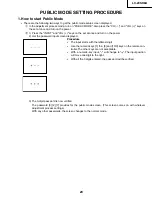
LC-20SH6U
13
ADJUSTING PROCEDURE OF EACH SECTION
The best adjustment is made before shipping. If any position deviation is found or after part replacement is
performed, adjust as follows.
1. Preparations
(1) Plug the AC power cord directly into a wall outlet.
[1] Adjustment procedure
1-1. Adjusting the checker
Turning on the power (initialization)
→
Making the model and size settings
→
Transferring the model-related
data to the setting E2PROM (I2C)
1-2. Adjusting the finish process
Final assembling
→
Turning on the power
→
Calling the adjustment process mode (bus connector)
→
Adjusting
the common bias, TAMP and white balance (cut-off and gain) settings
[2] Calling the checker mode/adjustment process mode
2-1. Calling the checker mode
Keep KEY5 (pin (82) of microprocessor) at "L" and turn on the power.
KEY-4 KEY-5
Mode shift
H
H
Normal mode (Data is written and stored on EEP is brand-new.)
L
H
Shift to adjustment mode
H
L
Activated with the checker-oriented master ROM values (EEP still brand-new even after the
checker mode)
L
L
The EEP gets initialized and the microprocessor's master values are written.
(Process-adjusted settings not reprogrammed)
2-2. Calling the adjustment process mode
There are two ways to call this mode.
* Turn on the power and press the "ADJUST PROCESS" key on the remote controller.
* Keep KEY4 (pin (81) of microprocessor) at "L" and turn on the power.
* For servicing: Hold down the INPUT key and VOL (–) key at once, and turn on the power switch.("K" appears at
the top left of the screen to indicate the inspection process mode.)
→
Press the CH (
ù
) key and VOL (–) key at
once. (The adjustment process mode screen shows up.) _ To quit, turn off the power. (Or turn off the power switch
or turn off the remote controller.)
[3] Key operation in the adjustment process
Basic operation
3-1. Selecting the receiving channels
* Using the CH (
Ù
)/(
ù
) keys, turn up and down an actual receiving channel.
Snap press: The channels are turned up and down one by one.
Continuous press: The next receivable channel is searched.
* Various adjustments: The items are adjusted one by one by selecting on the menu screen and using the cursor
key and VOL (+)/(–) keys.
* With the CURSOR UP/DOWN keys, select an adjustment item.
* Using the MENU key, the adjustment items are selected one after another. When the bottom item on a page is
already selected and the MENU key is pressed, the top item on the next page is selected.
* If any item on a page is selected and the preset key is pressed, the top item on the next page is selected.
Page 1
→
Page 2
→
Page 3
→
Page 7
→
Page 9
→
Page 1 ...
* If any item on a page is selected and the manual memory key is pressed, the top item on the same page is
selected.
* Using the CURSOR LEFT/RIGHT keys and VOL (+)/(–) keys, turn up and down the setting of a selected item.
Hierarchical shift
* When the ENTER key is pressed on any item other than I2C DATA on page 4, the setting page of the item shows
up.
* To quit the setting page, press the front screen key.














































